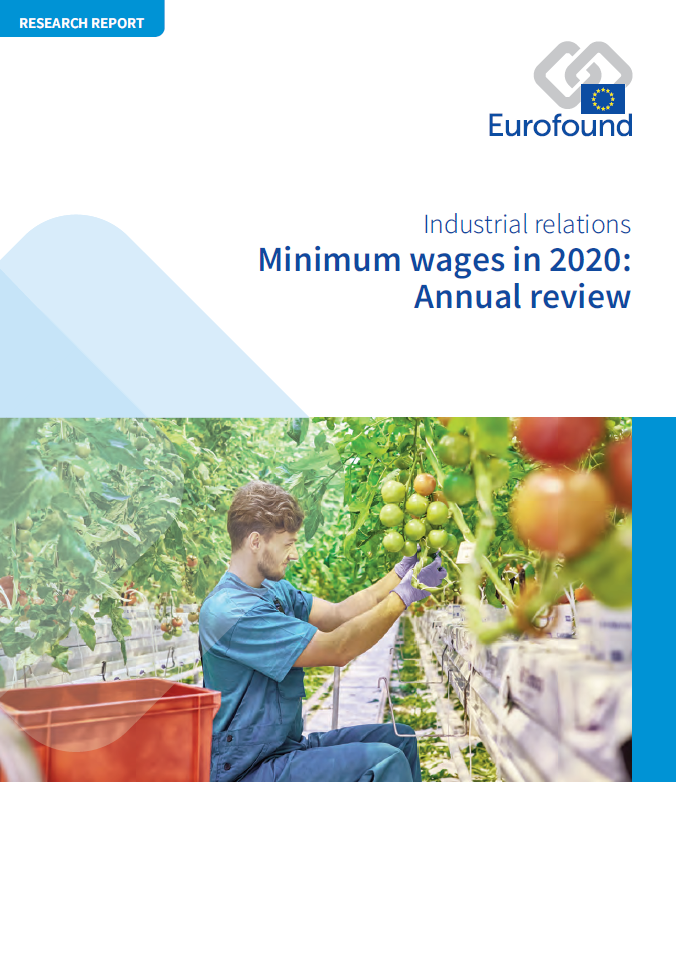
Den här rapporten ingår i en årlig publikationsserie om minimilöner och sammanfattar den viktigaste utvecklingen under 2019 och i början av 2020 inom EU:s initiativ för rättvisa minimilöner samt sätter de nationella debatterna om fastställandet av nivån för 2020 och därefter i ett sammanhang. I rapporten redogörs för hur minimilöner har fastställts och den roll arbetsmarknadens parter spelar. Vidare diskuteras utvecklingen av lagstadgade minimilöner, och för länder utan lagstadgade minimilöner presenteras uppgifter om lägstalöner i kollektivavtal för tio låglöneyrken. Rapporten omfattar även ett avsnitt som rör de regionala aspekterna av minimilöner och redogör för den senaste forskningen om vilka effekter ändringar av minimilöner har på löner, sysselsättning, fattigdom bland förvärvsarbetande, priser och vinster.
Key findings
Under 2019 debatterades i många länder en ytterligare betydande ökning av minimilönerna efter 2020, dels i förhållande till ett relativt mål, dels i absoluta tal.
Lagstadgade minimilöner har blivit rättvisare jämfört med andra arbetstagares löner sedan början av detta årtusende (vid en jämförelse av lagstadgade minimilöner med medianlönerna för samtliga arbetstagare).
Trots denna uppåtgående trend ligger minimilönerna i majoriteten av länderna fortsatt under 60 procent eller till och med under 50 procent av medianlönerna. Så är särskilt fallet i de central- och östeuropeiska medlemsstaterna, som startade från mycket låga relativa nivåer i början av detta årtusende och fortsätter ha mål runt eller under 50 procent i sina bestämmelser om minimilön.
Sammantaget anger sju av tio arbetstagare med minimilön att de åtminstone har vissa problem med att få ekonomin att gå ihop, jämfört med färre än fem av tio andra arbetstagare. Dessa siffror varierar emellertid kraftigt mellan olika länder. Till exempel uppgav mindre än 10 procent av arbetstagarna med minimilön att det var svårt till mycket svårt i Danmark, Finland, Tyskland och Sverige. I jämförelse var samma siffra 50–60 procent i Bulgarien, Kroatien och Cypern och 80 procent i Grekland.
Regeringar runtomkring i Europa reagerar med stabiliserande åtgärder för dem som påverkas av krisen i samband med covid-19. Minimilöner kan spela en roll i en politisk strategi för att stabilisera inkomster och således efterfrågan för att motverka en nedåtgående spiral mot recession eller depression.
Data
Find data on statutory minimum wages in the EU.
- Data: Proportion of minimum wage workers who find it difficult to make ends meet, EU average
- Data: Minimum wage developments in real terms, 15 euro area countries, 2015 price levels
- Data: Proportion of minimum wage workers who find it difficult to make ends meet
- Data: Statutory minimum wages - Minimum wages in the EU in 2020
List of tables
- Table 1: Social partners’ first reactions to the announced initiative on fair wages
- Table 2: Overview of main arguments and proposals concerning an EU minimum wage initiative from social partners
- Table 3: Gross minimum wages, selected EU Member States and the UK, 2019 and 2020
- Table 4: Sub-minimum rates for selected EU Member States and the UK as at 1 January 2020
- Table 5: Further statutory minimum wage rates for private sector workers in selected EU Member States
- Table 6: Number of collective agreements covering low-paying job categories for countries without statutory minimum wages
- Table 7: Minimum wages in collective agreements, applicable in 2019 for selected low-paid jobs
- Table 8: Collective agreement coverage in Finland
- Table 9: Overview of debates during 2019 on aspects of the minimum wage setting processes
- Table 10: Demands for and agreements on targets for future minimum wages to address adequacy in selected EU Member States and the UK
- Table 11: Regional statutory minimum wage rates
- Table 12: Latest minimum wage research in EU Member States and the UK
- Table 13: Overview of recent empirical research in the EU, Norway and the UK on employment impacts of minimum wage increases, 2019
- Table 14: Policies influencing in-work poverty
- Table A1: Network of Eurofound Correspondents – Members participating in the research
List of figures
- Figure 1: Conceptualising adequate minimum wages
- Figure 2: Estimated share of employees earning 90% to 110% of the minimum wage, EU Member States, 2017
- Figure 3: Proportions of female and male employees, EU level, 2017
- Figure 4: Proportion of minimum wage workers per sector, EU level, 2017
- Figure 5: Proportion of minimum wage workers per occupation (top 10), EU level, 2017
- Figure 6: Hourly minimum wages, selected EU Member States, 2020
- Figure 7: Minimum wage developments in real terms, 15 euro area countries, 2015 price levels
- Figure 8: Minimum wage developments in real terms, non-euro area, 2015 price levels
- Figure 9: Impact of purchasing power on the minimum wage value for selected EU Member States and the UK, as at 1 January 2020
- Figure 10: Relative distance between purchasing power of lowest and median minimum wage EU Member States and the UK and highest minimum wage EU Member States and the UK, 2010–2020
- Figure 11: Process for determining minimum wage rates for 2020
- Figure 12: Number of minimum wage rate updates, EU Member States with statutory minimum wages and the UK, since 2010
- Figure 13: Longer-term trend of development of statutory minimum wages relative to median wages of full-time employed workers, selected countries within the EU and the UK, 2000–2018
- Figure 14: Proportion of minimum wage workers who find it difficult to make ends meet, EU average
- Figure 15: Proportion of minimum wage workers who find it difficult to make ends meet
- Figure 16: Making ends meet and minimum wages in relative and absolute terms
- Figure 17: Monthly minimum wage as a proportion of the mean value of average monthly earnings by NUTS1 region, reference year 2016
- Figure 18: Regional variation of relative monthly minimum wages, by NUTS1 region, 2016
- Figure 19: Examples of countries with higher interregional differences in the proportion of minimum wage workers
- Number of pages
-
86
- Reference nº
-
EF20005
- ISBN
-
978-92-897-2068-7
- Catalogue nº
-
TJ-AS-20-001-EN-N
- DOI
-
10.2806/999852
- Permalink
Cite this publication
